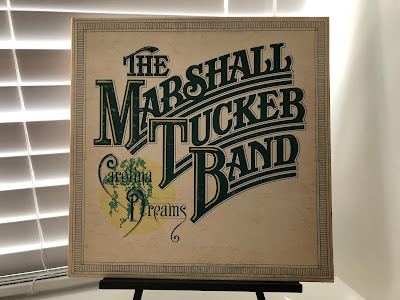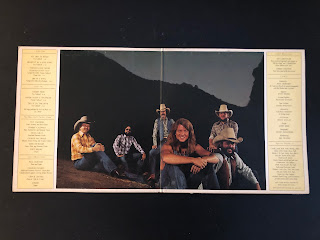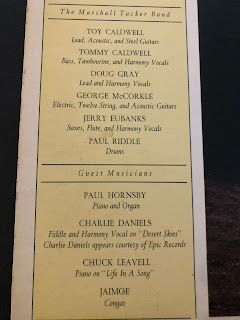What I know about The Marshall Tucker Band would fit on the back of a stamp, but I have heard some of their stuff over the years. Classic rock radio will play "Take the Highway" and "Can't You See" both from the band's debut. Those are pretty cool songs, and an interesting blend of country and southern rock that I always liked.
Let's just address the elephant in the room right off ... there was no one name Marshall Tucker in the band. Apparently the band was named after a sign the guys saw in a rehearsal space ... I think that's right. Regardless, turns out Marshall Tucker was a real guy, and tuned pianos. Good thing I'm not rambling about REO Speedwagon ... because you know, you can tune a piano, but you can't tuna fish.
Before I stray too far, let's just get back to the album. I had picked up a best of a while back, and I gave it a couple of spins. It was pretty decent, and touched the high spots. Of course now that I'm back to stuffing my shelves with vinyl, I'm always on the lookout for stuff, and when I found a copy of Carolina Dreams that was in better than passable shape (not by much, but it's very playable) I dropped by dollar and brought the album home for a little TLC.The band had been steadily building their base, and four of their previous album's had all gone gold. Oddly the album that preceded Carolina Dreams, Long Hard Ride did well, but missed out being certified. Who knows what happened there, but for whatever reason Carolina Dreams would be the bands only album to go platinum. "Heard it in a Love Song" was a pretty decent hit, and was a top forty hit on both the country and pop charts.
Listening to this now, it really is a wonderful blend of country, rock, easy listening, and even some jazz elements - particularly some of the guitar work by Toy Caldwell, who wrote many of the songs on the album. The songs cover a lot of ground musically, and the band did stretch things out when necessary to make sure the ideas were fully realized. They weren't padding the songs by any stretch of the imagination. When you have a song clocking in at just over seven minutes you wonder if there's unnecessary padding - nope, all killer no filler. To that end, the closing track on the first side, "Life in a Song" written by guitarist George McCorkle, and Jerry Eubanks, the band's sax and flute player, was actually too short. I know you want to leave people wanting more. Lead guitar player Toy Caldwell absolutely blows the roof off, and before you know it, it's over.Flipping the album over the second side starts out with a jazz shuffle, with a steel guitar and fiddle. Yeah, it works. This is the kid of song that often wears thing pretty quickly, but the boys took "Desert Skies" and turned it into a mini showcase for the band. Charlie Daniels guests and takes a fiddle solo. While really not my cup of tea, it's a pretty wicked piece of music, and in the context of the album it works. "Never Trust a Stranger" is probably one of my favourite from the album, and has an absolutely wicked groove, and a great flute part. The third side only had three songs and the closing track "Tell it to the Devil" was pushing seven minutes, and like the other songs, the boys weren't in a rush to close out the track. I'm sure things could have been trimmed to squeeze out a few bits here and there, but the charm in the song is the interplay between the players and I'm okay hearing more than one solo in a song.
I still find this period of the mid to late '70s interesting as there was so much diversity in what was available. The Marshall Tucker Band was at home with blistering southern rock, as they were mining their own version of "adult contemporary" on a song like "Heard it in a Love Song" - and they had a flautist and that was pretty friggin' cool.The band would follow up Carolina Dreams in 1978 with their final album for Capricorn Records, Together Forever. It would be their last gold record, but not their last record.
The classic line up:
- Toy Caldwell - lead, acoustic and steel guitars
- Tommy Caldwell - bass, tambourine, and harmony vocals
- Doug Cray - lead and harmony vocals
- George McCorkle - electric, twelve string, and acoustic guitars
- Jerry Eubanks - saxes, flute, and harmony vocals
- Paul Riddle - drums




Comments
Post a Comment